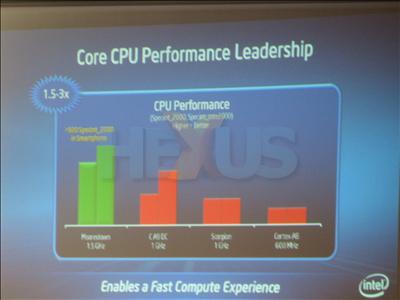How worried should ARM be?
But it's in performance that Intel reckons it has the advantage. For a start Moorestown clocks at 1.5 GHz compared to a current ceiling of around 1 GHz for ARM-based chips (although 1.5 GHz isn't far away). On top of that Intel has licensed some Imagination Technologies Power VR IP and integrated it into the SoC to ensure good graphics performance.
The slide below shows some benchmarks using Specint 2000, comparing Moorestown with ARM's Cortex A9 and A8 cores as well as Qualcomm's Scorpion core - the CPU inside Snapdragon.
During the presentation, Kedia demonstrated the Aava Mobile reference platform displaying two video streams at once, while transmitting another from the front-facing camera. In fact video was a prominent feature in the whole presentation, with Kedia claiming Intel is the first smartphone chip-maker to offer full 1080p video playback.
Long-time graphics rival NVIDIA might have something to say about that. In our recent look at its second-generation Tegra SoC, NVIDIA claimed the ability to play and record 1080p video and furthermore boasted 8 hours of playback, compared to 4-5 hours for Moorestown.
In the context of smartphones, however, it's questionable how useful all this 1080p goodness is, as by definition (excuse the pun) none of them have screen sizes large enough to appreciate full HD. So we reckon Moorestown, like Tegra 2, will have more of an impact in the tablet/slate market than in smartphones.
Moorestown can be clocked up to 1.9 GHz in tablets, thus offering even more performance, and will start to appear in such devices in the second half of this year, while Intel isn't yet predicting when we'll be able to buy a smartphone with Intel inside. It did confirm that, as well as Meego/Moblin, the Atom Z6xx series already supports Android. We'd be surprised if at least Windows Phone 7 and webOS at least don't follow in due course.
We'll follow-up with a closer look at what Intel has done to get its Atom architecture down to these power levels, but right now this looks like Intel's initial shot across the bows of ARM. There remain a lot of hurdles in the way of Intel chips becoming commonplace in smartphones, but this launch marks just the first step in a long-term strategy for the world's biggest chip-maker to become a player in the phone market. The ARM ecosystem should take note.














